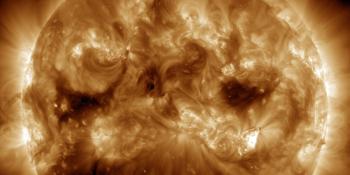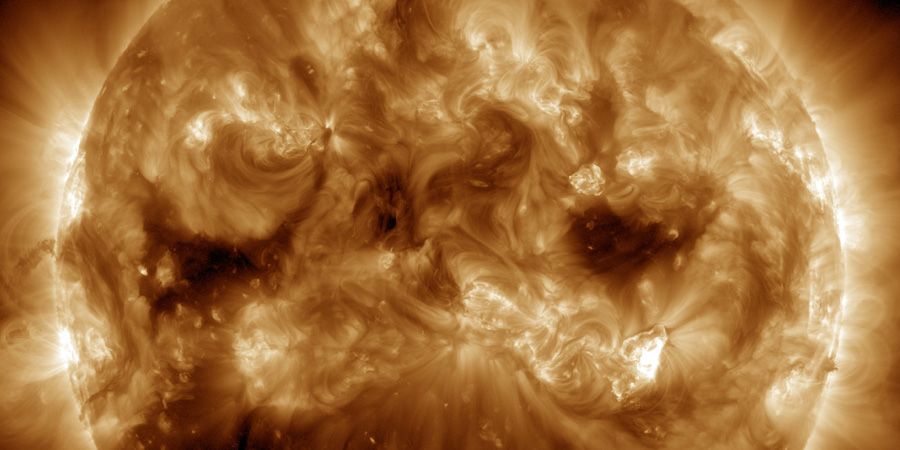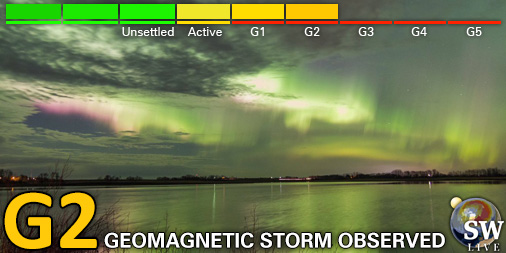Viewing archive of Sunday, 6 November 2011
Geophysical report
Prepared by the NOAA © SWPC and processed by SpaceWeatherLive.com
Joint USAF/NOAA Solar and Geophysical Activity Summary
SGAS Number 310 Issued at 0245Z on 06 Nov 2011 This report is compiled from data received at SWO on 05 NovA. Energetic Events
Begin Max End Rgn Loc Xray Op 245MHz 10cm Sweep 0308 0335 0358 1339 N20E45 M3.7 1f 0524 0524 0524 250 0732 0732 0732 160 0744 0745 0746 220 1110 1121 1142 1339 N21E42 M1.1 Sn 1342 1342 1342 380 2031 2038 2054 1339 N21E34 M1.8 1n
B. Proton Events
C. Geomagnetic Activity Summary
D. Stratwarm
E. Daily Indices: (real-time preliminary/estimated values)
10 cm 172 SSN 123 Afr/Ap 003/004 X-ray Background B8.1 Daily Proton Fluence (flux accumulation over 24 hrs) GT 1 MeV 4.6e+05 GT 10 MeV 9.5e+04 p/(cm2-ster-day) (GOES-13 satellite synchronous orbit W75 degrees) Daily Electron Fluence GT 2 MeV 9.40e+06 e/(cm2-ster-day) (GOES-13 satellite synchronous orbit W75 degrees) 3 Hour K-indices Boulder 1 1 2 1 2 2 1 1 Planetary 2 1 1 1 1 0 0 1
F. Comments
None
All times in UTC
Current data suggests there is a slight possibility for aurora to appear at the following high latitude regions in the near future
Gillam, MB, Iqaluit, NU, Yellowknife, NTNuuk
Latest news
Latest forum messages
Support SpaceWeatherLive.com!
A lot of people come to SpaceWeatherLive to follow the Sun's activity or if there is aurora to be seen, but with more traffic comes higher server costs. Consider a donation if you enjoy SpaceWeatherLive so we can keep the website online!

Latest alerts
Saturday, 22 March 2025
23:45 UTC - Geomagnetic activity
Minor G1 geomagnetic storm (Kp5) Threshold Reached: 23:37 UTC
Strong G3 geomagnetic storm watch for 23 March
Yesterday around 16 UTC an M1.2 solar flare took place around sunspot region 4028. The solar flare triggered a filament eruption which erupted from the center of the earth-facing solar disk.
Read more12:18 UTC - Hemispheric Power Index
The OVATION model predicts the Hemispheric Power Index to reach 75GW at 13:10 UTC
03:45 UTC - Geomagnetic activity
Minor G1 geomagnetic storm (Kp5) Threshold Reached: 03:35 UTC
03:15 UTC - Geomagnetic activity
Moderate G2 geomagnetic storm (Kp6) Threshold Reached: 02:59 UTC
Space weather facts
| Last X-flare | 2025/02/23 | X2.0 |
| Last M-flare | 2025/03/21 | M1.2 |
| Last geomagnetic storm | 2025/03/22 | Kp6- (G2) |
| Spotless days | |
|---|---|
| Last spotless day | 2022/06/08 |
| Monthly mean Sunspot Number | |
|---|---|
| February 2025 | 154.6 +17.6 |
| March 2025 | 140.3 -14.3 |
| Last 30 days | 140 -11.7 |






